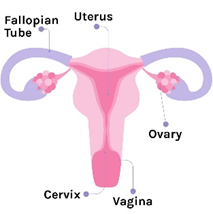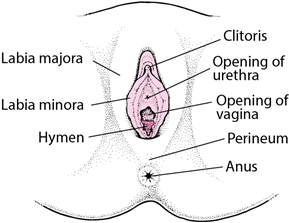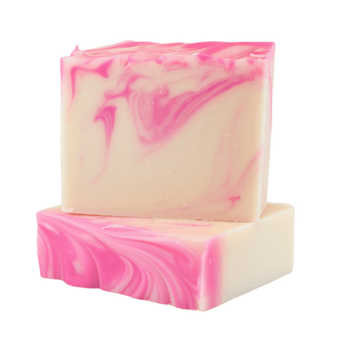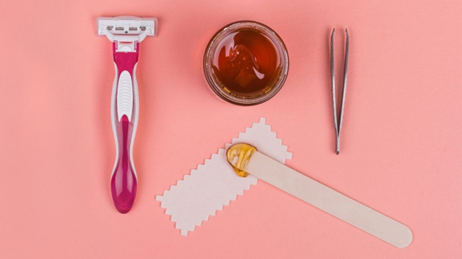Getting to know your own anatomy and feeling comfortable discussing what is normal and not normal is an important part of addressing pelvic floor dysfunction. This may come more or less easily to different individuals for a variety of reasons, including but not limited to, your upbringing, your community and religion, and your social circle. Although these tips are not directly for the pelvic floor itself, we want to maintain healthy external genitalia to minimize the possibility of pelvic floor dysfunction. So, outside of pelvic floor PT, maintaining a healthy diet, getting enough sleep, meeting exercise guidelines, and implementing good toileting habits, how else can you be supporting a healthy “down there” area? Keep reading to find out how to take care of some of your most sensitive body parts and support a healthy pelvic floor.
First, let’s talk about the anatomy of the female genitalia and clarify some terms. The vulva is what is colloquially, and incorrectly, termed the “vagina” – the external female genitalia that you can see which includes the labia majora (the bigger folds of tissue) and the labia minora (the smaller folds of tissue within the labia majora), the mons pubis (the area over the pubic bone) as well as the clitoris (female erogenous nerves), and the opening of the urethra (where we pee from) all make up the vulva.

So, what’s the vagina then? The vagina is the canal that connects the vulva (outside) to the cervix (inside). This is where babies are birthed from and where penetrative intercourse occurs.

- Cleaning: Soaps and “Feminine Washes”
Companies that sell these products want you to think that your vulva is dirty so that they can sell you their “pink taxed” products with special “pH balancing” blends, but in reality, a vagina is a self-cleaning machine through its natural discharge. Don’t douche unless you have been prescribed a medication by your medical doctor. Douches can actually disrupt the natural chemical balance of the vagina and remove the healthy bacteria that live in there which can actually increase the risk of bacterial vaginosis. Your genitals do not need to smell like roses (roses should smell like roses) so feminine sprays and deodorants are not recommended. If you have a change in discharge scent or discoloration with associated itching, burning or discomfort – seek medical attention.
How do you wash the vulva then if not with scented soaps? Simply rinse the labia majora and minora daily with warm water and your hands or a very gentle washcloth, do not rinse the inside of the vagina. If you are someone that just can’t get on board with not using soap, then choose one that is pH neutral for the outer labia to avoid increasing irritation to this area.
Wipe from the front to the back, or the front first and then the back. This minimizes the chances of smearing fecal matter on the vulva which could cause a transfer of bacteria which in turn could cause a urinary tract infection (UTI).

- Hair Removal
Like most of the hair on our body – our pubic hair is there for a reason and that reason is protection. It helps protect the vulva against bacteria and it reduces friction during intercourse. I recently read one article that referred to pubic hair as a “dry lubricant” due to the fact that it is easier to rub the hair against hair than it is to rub skin against skin. Like all parts of our body, we want to make sure that we are keeping hair in this area clean, but to keep or get rid of it is a personal choice!
The only benefit to removing pubic hair could potentially be a decrease in odor, minimizing sweat that gets trapped in the hair which could lead to a smell. On the other hand, there are several risks associated with hair removal. Some of these risks can include razor burn, cuts, ingrown hairs, itching, and redness. Having open wounds (like nicks and cuts from a razor) could increase the risk of skin infection.

- Clothing
100% cotton underwear is one of the gentler fabrics so wouldn’t you want that on one of the most sensitive parts of your body? Cotton is breathable and also helps to absorb extra moisture from normal vaginal discharge. Wearing synthetic materials like spandex and nylon can trap heat and moisture due to the non-breathable material which creates a great environment for (bad!) bacteria to thrive.
Good news for everyone who likes to wear a thong – thongs have not been found to be associated with an increased risk of UTIs, bacterial vaginosis, or yeast vaginitis. This is because the microenvironment (skin pH, microflora, and microclimate) of the vulva does not change with the different styles/shapes of underwear.
Change out of sweaty clothes after a workout to avoid creating a warm, moist environment that bacteria love.
Certain laundry detergents and fabric softeners can be an irritant to the skin of the vulva – when possible, use hypoallergenic detergents and no softeners for washing underwear to minimize allergic reactions.
If you have incontinence (firstly, come see me!) ensure that you are wearing an incontinence pad and not a menstrual pad. Menstrual pads are designed to hold smaller quantities of fluid and are less absorbent therefore can cause irritation to the perineal area when in contact with it for prolonged periods of time.

- Sex and Pleasure
Have sex! If that is something you enjoy.
Not all lubricants are made equal. Check the ingredients in the lubricant you use (and make sure that it is compatible with any toys or pelvic floor equipment you may use – like a dilator or pelvic floor wand) so that it does not break down the material. Certain lubricants contain ingredients that could disrupt the natural pH of the vagina. Ingredients to avoid include anything with scents, flavors, dyes, glycerin, petroleum, parabens, foods, and non-natural oils. Safe options include water-based lubricants that have been FDA approved for internal use. Check the expiration date on these products.
When having intercourse, if you switch between vaginal and anal penetration, use a new condom for a new hole or wash the inserting object before switching locations to minimize the spread of bacteria from the anus to the vagina and vice versa.

Now that you know how to take care of your vulva and vagina, read our blog on tips and tricks to keep the pelvic floor happy and healthy for the ultimate guide to forming great habits for the “down there” region!
 This blog was written by our very own Pelvic/Women’s Specialist, Dr. Sam Greig.
This blog was written by our very own Pelvic/Women’s Specialist, Dr. Sam Greig.
References
https://my.clevelandclinic.org
* * *
Thanks for reading! If you’d like to learn more about who we are and what we do, click this link: https://upandrunningpt.com/

